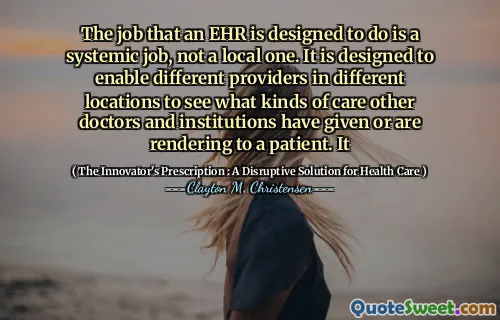
The job that an EHR is designed to do is a systemic job, not a local one. It is designed to enable different providers in different locations to see what kinds of care other doctors and institutions have given or are rendering to a patient. It
Electronic Health Records (EHRs) are fundamentally about fostering a more integrated and coordinated healthcare system. The essence of the quote emphasizes that the true purpose of EHRs extends beyond simple documentation or local record-keeping; their goal is systemic integration. By enabling various healthcare providers—regardless of their geographical location or organizational affiliation—to access comprehensive patient information, EHRs aim to create a connected care continuum. This interconnectedness is critical for delivering high-quality, timely care, especially in complex cases where multiple specialists or institutions are involved. When healthcare providers have seamless access to a patient's history, recent tests, and ongoing treatments, it reduces redundancy, minimizes errors, and accelerates decision-making. Moreover, systemic data sharing supports population health management, research, and policy development by providing broader insights into health trends and outcomes. The challenge, however, lies in balancing information sharing with privacy concerns, ensuring interoperability between diverse health IT systems, and maintaining data security. The transformational potential of EHRs rests on their capacity to create a unified data ecosystem, moving healthcare from fragmented silos toward a holistic, patient-centered approach. This systemic view aligns with the broader goal of improving health outcomes and making care delivery more efficient, adaptive, and person-centered. As the healthcare industry continues to evolve technologically, the importance of viewing EHRs as tools for systemic integration rather than mere documentation cannot be overstated, as it is fundamental for realizing the promise of digital health innovations.






